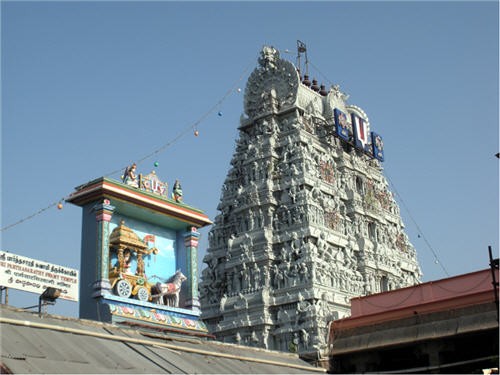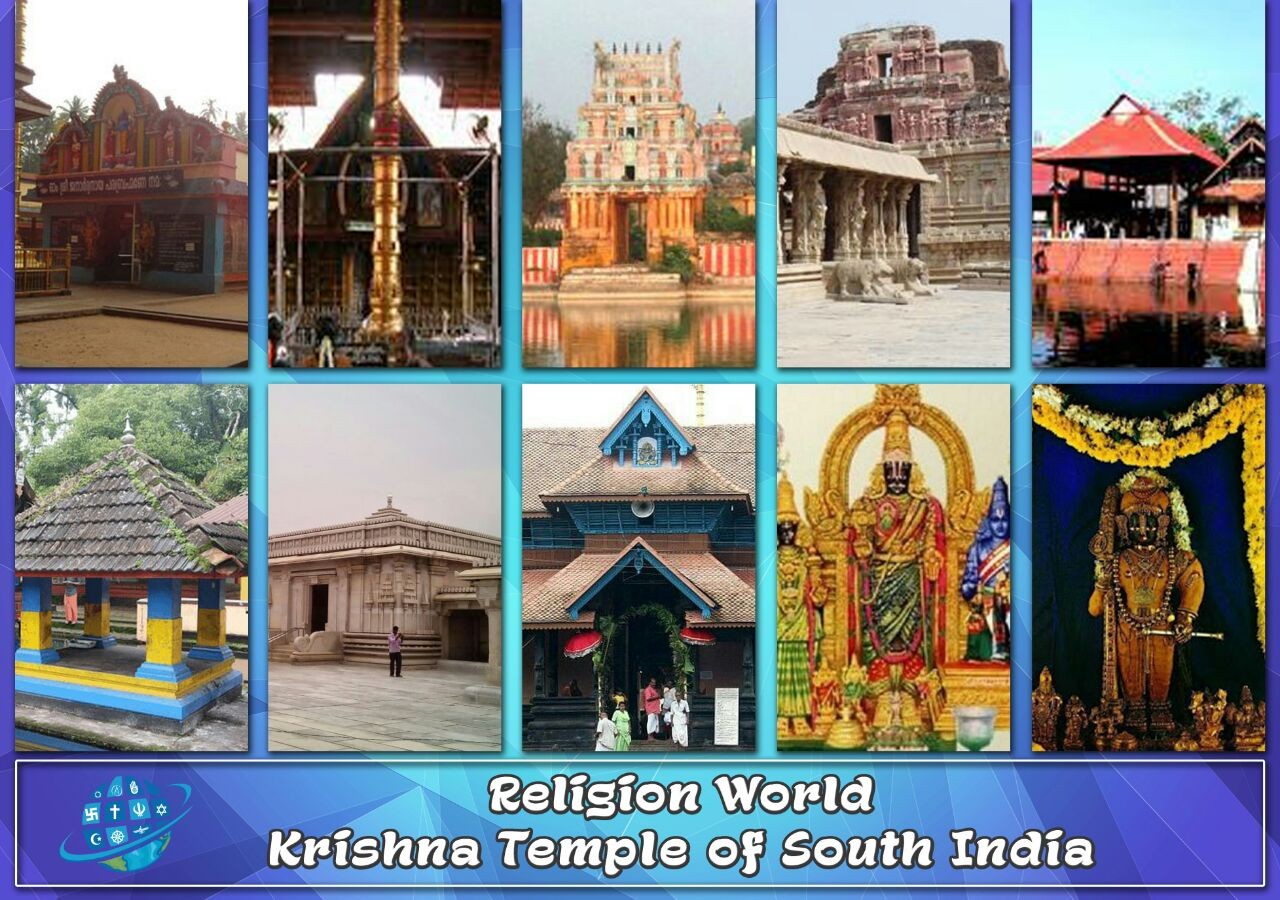Krishna Temples of South India – Celebrating Janmashtami in style
Janmashtami (popularly known as Krishnastami in south India) is a major festival in this part of the country as well. The festival is celebrated with gaiety and pious devotion. Though all the Hindus celebrate this festival, Vaishnaviates make this a big feast. The celebrations range for music & dance; to decking up house & temples; to cooking wonderful food for family & friends. Here we present the 10 famous Lord Krishna temples in south India that are a must visit places for all.
Come Sravana month, the holy festival of Janmashtami arrives. Lord Krishna is revered in the entire nation and this festival is gloriously celebrated with bhajans, prayers and dancing in devotion. You must be busy planning as to where you should travel on this auspicious occasion.
If you are in South India this Janmashtami (popularly known is down south as Krishnastami), then there are famous Krishna temples must be made part of your festival celebrations this year.
Here are some of the Krishna temples of South India which are visited by the devout and dedicated followers of Lord Krishna. You can choose from the list of temples given below to celebrate Janmashtami this year.
1. Guruvayur Srikrishna temple
 Situated at Guruvayur in Kerala, it is one of the revered Krishna temples in India. The deity residing here is a four armed Lord Krishna with a conch, discus, mace and lotus. He also adorns a basil garland. Guruvayur is considered as Dwarka of South India. The idol here is constructed of Patalanjana stone which makes the temple unique.
Situated at Guruvayur in Kerala, it is one of the revered Krishna temples in India. The deity residing here is a four armed Lord Krishna with a conch, discus, mace and lotus. He also adorns a basil garland. Guruvayur is considered as Dwarka of South India. The idol here is constructed of Patalanjana stone which makes the temple unique.
It is one of the fourth biggest temple in India regarding to the number of devotees per day legends, the deity worshipped here is more than 5000 years old. In the 14th century, “Kokasandesam” (a Tamil literary work), references to a place called Kuruvayur are made. In ancient Dravidian languages, “kuruvai” means “sea”, hence the village on the Malabar Coast may be called Kuruvayur. The earliest temple records date back to the 17th century. The battles between the Kozhikode under Samoothiris and Valluvanad popularised Guruvayur Temple. By the end of the 18th century Guruvayur had become the most popular pilgrimage centre in Kerala
2. Udipi Srikrishna
 One of the popular Krishna temples in South India, this idol is famous for being decked up by jewels. Madhwacharya is believed to be the founder of this temple. Devotees will have darshan through the inner window, known as Navagraha kindi
One of the popular Krishna temples in South India, this idol is famous for being decked up by jewels. Madhwacharya is believed to be the founder of this temple. Devotees will have darshan through the inner window, known as Navagraha kindi
The Krishna Matha in Udipi was founded by the Vaishnavite saint Jagadguru Shri Madhwacharya in the 13th century. He was the founder of the Dvaita school of Vedanta. Legend says that Madhwacharya found the idol of Sri Krishna in a large ball of sandalwood paste. A folklore story says that once Kanakadasa, a pious worshipper and devotee of Lord Krishna, was staying in a makeshift hermitage in front of Krishna mutt. He was not allowed to enter the temple as he was an untouchable. However, pleased with his devoutness, the idol facing the direction of east turned to west and there was a crack in the wall wide enough for Kanakadasa to have darshana of the murti.
3. Varkala Janardhana Swamy
 One of the oldest temples of South India, a Krishna temple of 2000 years old, is situated in Varkala. The temple is also considered to be an important Ayurveda centre. The deity is a form of Lord Vishnu and found performing Aachamanam or purification ritual.
One of the oldest temples of South India, a Krishna temple of 2000 years old, is situated in Varkala. The temple is also considered to be an important Ayurveda centre. The deity is a form of Lord Vishnu and found performing Aachamanam or purification ritual.
It is said that sage Narada, after paying his respects to Lord Narayana, left Vaikuntam to see Brahma. Enraptured by the sweet music of Narada, Narayana followed him unobserved. When Narada reached Brahmaloka, Brahma saw Narayana following his son Narada and offered salutations to Him, at which Vishnu, realizing the awkward situation, suddenly disappeared. Brahma found that the person whom he had revered was his own son, Narada. The ‘Prajapathis’ who were laughing at this incident were cursed by Brahma that they would be born on earth and suffer the miseries of human beings. Narada advised them to perform penance at the place he himself would select for them. Narada threw his ‘Valkalam’ (bark upper garment) into the air and at the place where it fell down, they consecrated a temple for Janardanaswamy (a name of Vishnu). Hence the name Varkala is a corruption of ‘Valkala’.
4. Parthasarathy Koil Triplicane
 Situated in Triplicane, heart of Chennai, this Krishna temple finds its mention by the laureates of Tamil literature of 6th and 9th century. One of the oldest temples of Chennai, it is an important religious site of South India.
Situated in Triplicane, heart of Chennai, this Krishna temple finds its mention by the laureates of Tamil literature of 6th and 9th century. One of the oldest temples of Chennai, it is an important religious site of South India.
As per Hindu legend, Saptarishis, the seven sages worshipped five deities Panchaveeras, namely, Venkata Krishnaswamy, Rukmini, Satyaki, Balarama, Pradyumna and Aniruddha. As per Mahabharatha, Vishnu, in his avatar as Krishna was acting as charioteer for Arjuna, the Pandava prince during the war with Kauravas. Krishna did not take any weapons during the war. During the fight between Arjuna and Bhishma, Krishna was injured by the arrow from Bhishma. The mark in the image in the temple is believed to follow the legend. The place is called Allikeni, meaning a pond of lily as it is believed that historically the place was full of lily ponds. The place is the only place where the presiding deity is sported with a mustache. As per another legend, the place was once a Tulsi forest. A king named Sumati wanted to see Vishnu in the form of Parthasarathi and prayed at Srinivasa temple in Tirupathi. Srinivasa directed the king to visit the temple here built by sage Atreya and worshipped with another sage called Sumati.
5. Mysore Venugopalaswamy temple
 This is yet another Krishna temple of Hoysala architecture, residing in Mysore at Karnataka. It is located beside Krishnaraja Sagara Dam in Mysore. This temple of Lord Krishna had the main idol of Venugopalaswamy where the idol was seen playing a flute. This temple along with two others got submerged and was later rehabilitated. This temple was built in the 12th century AD around the same time as the Chennakesava Temple at Somanathapura, Mysore district.
This is yet another Krishna temple of Hoysala architecture, residing in Mysore at Karnataka. It is located beside Krishnaraja Sagara Dam in Mysore. This temple of Lord Krishna had the main idol of Venugopalaswamy where the idol was seen playing a flute. This temple along with two others got submerged and was later rehabilitated. This temple was built in the 12th century AD around the same time as the Chennakesava Temple at Somanathapura, Mysore district.
6. Balakrishna temple, Hampi
 Balakrishna Temple was constructed by Krishnadevaraya in 1513 AD, after his victory over Utkala. The main idol established there is now displayed in Chennai State Museum. The carvings on the pillar and temple halls comprise an important part of South India temple architecture.
Balakrishna Temple was constructed by Krishnadevaraya in 1513 AD, after his victory over Utkala. The main idol established there is now displayed in Chennai State Museum. The carvings on the pillar and temple halls comprise an important part of South India temple architecture.
The main idol installed in the temple was the figure of Balakrishna (Lord Krishna as infant). This is one of the must see sites in Hampi. The carvings are especially spectacular with the Yalis (the mythical lion) on the pillars and the entrances to the temple hall flanged with impressive carvings of elephant balustrades.
This is one of the few temples where the epic stories carved on the walls of the tower. This is fairly an intact specimen of a Vijayanagara era temple.
7. Rajagopalaswamy temple, Mannargudi
 This renowned Krishna temple is situated at Mannargudi in Tamil Nadu. Rajagopalaswamy is the idol residing at the temple which is a form of Lord Krishna. It is also known as Dakshina Dwarka. The temple is spread over an area of 23 acres and is one of the important Vaishnavite shrines in India.
This renowned Krishna temple is situated at Mannargudi in Tamil Nadu. Rajagopalaswamy is the idol residing at the temple which is a form of Lord Krishna. It is also known as Dakshina Dwarka. The temple is spread over an area of 23 acres and is one of the important Vaishnavite shrines in India.
This ancient temple was massively expanded by Thanjavur Nayaks during the 16th century. The temple has three inscriptions from the period and also mention in the religious texts. A granite wall surrounds the temple, enclosing all its shrines and seven of its nine bodies of water. The temple has a 192 ft (59 m) Rajagopuram, the temple’s gateway tower.
8. Ambalappuzha Sri Krishna Temple, Alleppey
 Located in Alleppey, Lord Krishna in this temple is associated with Parthasarathi. The deity here holds a whip and conch in both the hands. The payasam and the sweet pudding served here has mythological significance. Amabalapuzha Temple festival is very famous here and it signifies bringing of Lord Krishna to the temple.
Located in Alleppey, Lord Krishna in this temple is associated with Parthasarathi. The deity here holds a whip and conch in both the hands. The payasam and the sweet pudding served here has mythological significance. Amabalapuzha Temple festival is very famous here and it signifies bringing of Lord Krishna to the temple.
This temple is directly associated to the Guruvayoor Sree Krishna Temple. During the raids of Tipu Sultan in 1789, the idol of Sri Krishna from the Guruvayoor Temple was brought to the Ambalappuzha Temple for safe keeping. It was kept safely for 12 years.
The payasam served in the Ambalappuzha Temple is famous. This sweet pudding made of rice and milk has an interesting mythological legend behind it. It is believed that Guruvayoorappan reaches here daily at the time of Palpayasa Nedyam to have it.
9. Aranmula Parthasarathy Temple, Mallapuzhassery, Kerala
 Counted amongst the Divya Desam, 108 Vishnu temples that are mentioned in the works of the Tamil Azhvars, Aranmula Parthasarathy Temple is sacred to Parthasarathy, which is another name of Krishna on account of his character as the charioteer of Arjun in Mahabharat.
Counted amongst the Divya Desam, 108 Vishnu temples that are mentioned in the works of the Tamil Azhvars, Aranmula Parthasarathy Temple is sacred to Parthasarathy, which is another name of Krishna on account of his character as the charioteer of Arjun in Mahabharat.
The temple is mainly known for the fact that it is one of the major stopover points of the procession that carries sacred jewels called Thiruvabharanam to Sabarimala. Also, the Thanka Anki, the golden attire of Ayyappa, which were donated by King of Travancore, is safeguarded in this temple. The main sanctum of the temple, locally called Sreekovil, is the place where the main image of the presiding deity resides, which can be only approached Thantri (main priest), and Melshanthi (second priest).
10. Trichambaram Temple, Thaliparamba
 Trichambaram Temple is situated in the Kannur district of Kerala, South India. As per the locals, the temple got its name from Thiru Shambara, a maharishi, who have meditated here. An idol of Lord Krishna depicting Raudra (ferocious posture) after Kamsavadham – killing of the demon king Kamsan adorns the holy place of the temple. Trichambaram Temple is known for Kumbham festival, which is held in the month of March. Architecture of the temple is renowned too.
Trichambaram Temple is situated in the Kannur district of Kerala, South India. As per the locals, the temple got its name from Thiru Shambara, a maharishi, who have meditated here. An idol of Lord Krishna depicting Raudra (ferocious posture) after Kamsavadham – killing of the demon king Kamsan adorns the holy place of the temple. Trichambaram Temple is known for Kumbham festival, which is held in the month of March. Architecture of the temple is renowned too.









